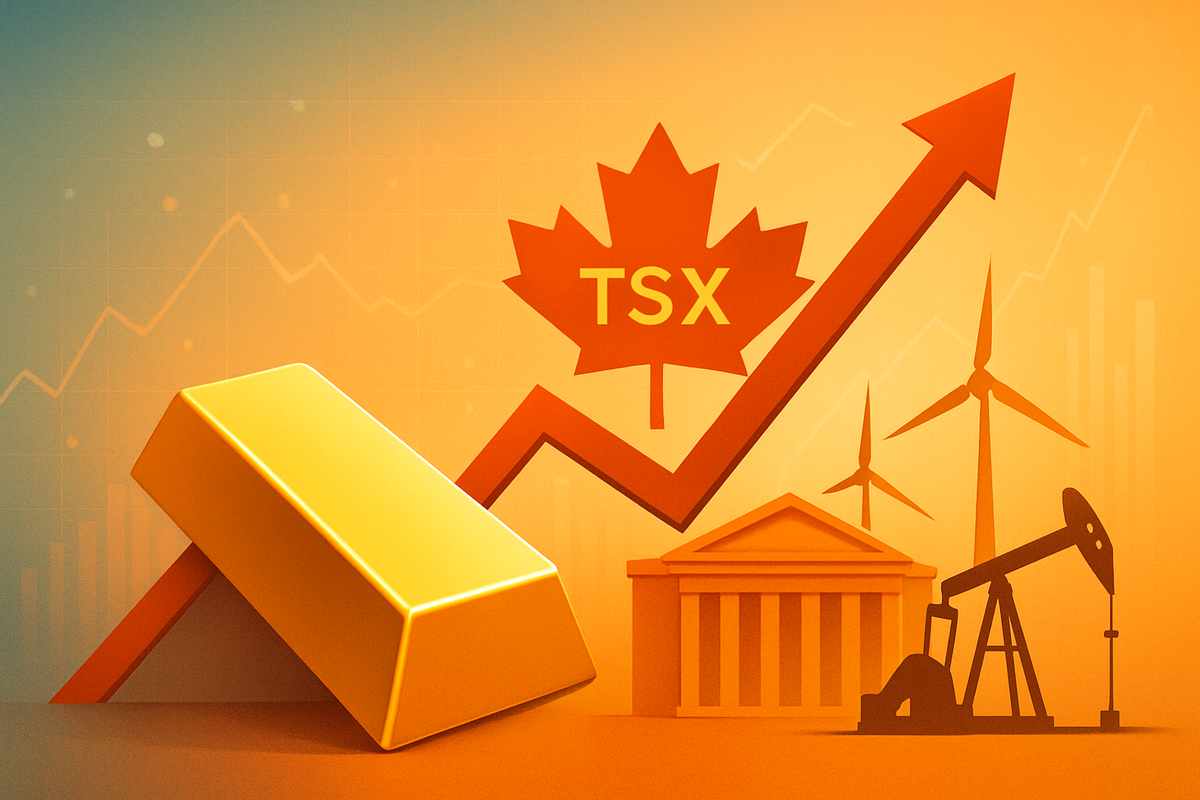Gold Shines as Canadian Stocks Stage Robust Comeback Amidst Strong US Jobs Data

In a dynamic turn of events in early November 2025, the Canadian stock market (TSX) has demonstrated a significant rebound, propelled by strong performances in its resource-focused sectors, particularly energy and materials. This resurgence comes alongside a notable rally in gold prices, which have defied expectations even in the face of robust US jobs data. The interplay between these factors paints a complex yet optimistic picture for investors, highlighting underlying safe-haven demand and a renewed confidence in commodity-linked industries.
The market's current trajectory suggests a nuanced response to global economic signals. While strong US employment figures typically strengthen the dollar and temper gold's appeal by reducing the likelihood of interest rate cuts, gold's sustained ascent underscores persistent investor anxieties regarding geopolitical tensions, inflation, and broader equity valuations. Concurrently, the Canadian market's impressive gains, nearing potential record highs, signal a powerful revival driven by fundamental strengths in its key export sectors.
Unpacking the Market's Resurgence: A Detailed Look
The catalyst for much of this market activity can be traced back to recent economic indicators. The US jobs market, despite a prolonged government shutdown delaying official statistics, showcased unexpected strength. The ADP National Employment Report for October 2025, released on November 5, indicated private employers added 42,000 jobs, exceeding forecasts and marking the first increase since July. This, coupled with a robust ISM Services PMI of 52.4% for October, reinforced the Federal Reserve's cautious stance on further interest rate reductions, leading to a repricing of market expectations.
Gold's journey this month has been particularly compelling. Initially, the precious metal experienced a slump following the Federal Reserve's October 29 meeting, where a 25 basis point rate cut was delivered, but Chair Jerome Powell's hawkish tone introduced uncertainty. Gold declined by 1.7% on November 4, coinciding with a strong US dollar. However, demonstrating remarkable resilience, gold rebounded sharply, climbing approximately 0.9% on November 5 to roughly $3,966.65 per ounce. By the end of the day, spot gold was up 1.2% at $3,977.94, with US gold futures for December delivery also rising. This rebound, occurring even amidst strong US payroll data, suggests that investors are increasingly prioritizing gold as a safe haven against global unease, geopolitical risks, persistent inflation, and concerns over potentially overvalued equities. Gold remains approximately 50% higher year-to-date, having touched record highs in October.
Concurrently, the S&P/TSX Composite Index has been on an impressive upward trajectory. On November 5, the TSX surged to 30,153 points, marking a 1.26% gain from the previous session and nearly 250 points in late-morning trading. Despite a modest 1.24% decline over the past month, the index stands an impressive 22.39% higher than a year ago and has surged over 20% year-to-date, pushing towards potential record highs. This robust performance is largely attributed to the stellar showing of Canada's resource-focused shares, with the materials and energy sectors leading the charge. This rally signifies renewed investor confidence in commodity-linked industries and an optimistic economic outlook for Canada, bolstered by easing interest rate pressures and strong corporate earnings forecasts.
The energy sector, in particular, has been a significant engine for the TSX's recent strength. The industry saw a 1.0% increase in the week leading up to November 5, with major players like Canadian Natural Resources (TSX: CNQ) experiencing a 1.1% gain. Over the past 12 months, the sector has collectively gained 13%, with earnings projected to grow by 5.6% per annum over the coming years. Companies such as Keyera (TSX: KEY) and Pembina Pipeline Corporation (TSX: PPL), leaders in the Natural Gas Liquids (NGL) space, are benefiting from strong industry fundamentals driven by growing output. A pivotal development supporting this growth is the completion of the Trans Mountain Pipeline expansion in November 2025, which has effectively doubled Canada's oil export capacity, opening new avenues for Canadian energy to reach global markets.
Corporate Winners and Losers in a Rebounding Market
The current market environment presents clear winners, particularly within Canada's resource-heavy sectors. Energy companies stand to gain significantly from sustained demand and improved infrastructure. Canadian Natural Resources (TSX: CNQ), a prominent oil and natural gas producer, has already seen positive movement and is poised for further growth given the sector's positive outlook and increased export capacity. Similarly, midstream players like Keyera (TSX: KEY) and Pembina Pipeline Corporation (TSX: PPL) are set to benefit from increased throughput and strong NGL fundamentals, as the expanded Trans Mountain Pipeline facilitates greater energy movement. These companies, with their robust infrastructure and strategic positioning, are well-placed to capitalize on Canada's growing energy output and access to global markets.
In the materials sector, gold miners and other precious metal producers are experiencing a significant tailwind from the rising price of gold. Companies such as Barrick Gold Corporation (TSX: ABX) and Newmont Corporation (TSX: NGT), major players in the global gold mining industry with substantial Canadian operations, are likely to see improved revenue and profitability as gold continues its impressive rally. The sustained safe-haven demand for gold, even amidst strong US economic data, provides a favorable operating environment for these companies, allowing them to potentially expand margins and increase shareholder returns. Junior miners and exploration companies, while higher risk, could also attract increased investor interest as the bullish sentiment around gold persists.
Conversely, companies heavily reliant on consumer discretionary spending or those sensitive to interest rate fluctuations might face more headwinds. While the overall market sentiment is positive, persistent inflation and the Federal Reserve's cautious stance on further rate cuts could impact sectors that thrive on lower borrowing costs or robust consumer confidence. Companies with high debt loads or those that have not adapted to evolving supply chain dynamics could also find themselves under pressure, even within a generally buoyant market. However, the broad-based nature of the TSX's rebound suggests that the negative impacts might be localized rather than systemic, with resource companies largely offsetting any weaknesses.
Broader Significance and Market Implications
This market dynamic fits into a broader trend of commodities asserting their role as hedges against global uncertainties. The sustained strength of gold, despite economic data that would typically challenge its appeal, underscores a prevailing sense of caution among investors. This "risk-off" sentiment, driven by geopolitical tensions, lingering inflation concerns, and a watchful eye on equity valuations, suggests that market participants are diversifying into tangible assets. This trend could indicate a more protracted period where real assets outperform financial assets, influencing capital allocation decisions across institutional and retail portfolios.
The ripple effects of Canada's energy sector resurgence are significant. The completion of the Trans Mountain Pipeline expansion is not just a win for individual energy companies but a strategic national asset. It enhances Canada's position as a reliable global energy supplier, potentially influencing international energy markets and diplomatic relations. This increased export capacity could lead to greater foreign investment in Canadian energy infrastructure and exploration, fostering job creation and economic growth beyond the immediate sector. For competitors, particularly those in the US and other oil-producing nations, it means increased competition in global markets, potentially impacting pricing dynamics and market share.
Regulatory and policy implications are also at play. The success of major infrastructure projects like the Trans Mountain Pipeline could embolden governments to pursue similar projects, balancing economic imperatives with environmental considerations. The ongoing debate around energy transition will continue to shape investment landscapes, but the current strength of traditional energy suggests that a pragmatic approach to energy policy, acknowledging both conventional and renewable sources, is gaining traction. Historically, periods of strong commodity prices have often correlated with robust economic growth in resource-rich nations like Canada, reminiscent of commodity supercycles observed in previous decades. This current environment suggests a potential return to such a cycle, albeit within a more complex global economic and environmental framework.
What Comes Next: Navigating Future Market Landscapes
In the short term, the market will likely remain highly responsive to incoming economic data, particularly from the US, and any developments in geopolitical hotspots. Investors will closely watch for further signals from the Federal Reserve regarding interest rate policy, as this will continue to influence both gold prices and broader market sentiment. The resilience of gold suggests that its safe-haven appeal will persist as long as uncertainties loom, potentially pushing it towards new record highs. For the Canadian market, the momentum in energy and materials is expected to continue, with quarterly earnings reports from these sectors providing key insights into their sustained profitability and growth trajectories.
Looking further ahead, the long-term possibilities for Canada's resource sectors appear promising, assuming global energy demand remains robust and commodity prices stay elevated. Strategic pivots for energy companies might involve continued investment in carbon capture technologies and efficiency improvements to align with environmental goals while maximizing traditional resource extraction. For mining companies, exploration for new deposits and optimization of existing operations will be crucial to maintain growth. Market opportunities could emerge in supporting industries, such as technology providers for resource extraction, environmental consulting, and infrastructure development.
Potential challenges include increased regulatory scrutiny on environmental impacts, volatility in global commodity prices driven by supply-demand imbalances or geopolitical events, and the ongoing talent crunch in specialized resource sectors. Scenarios could range from a sustained commodity supercycle, driving significant economic expansion in Canada, to a more moderated growth path influenced by global economic slowdowns or shifts in energy policy. Investors should prepare for continued volatility but also recognize the potential for substantial returns from well-positioned companies in these foundational sectors.
Comprehensive Wrap-up: Assessing the Lasting Impact
The recent market activity, characterized by gold's impressive rally and the Canadian stock market's strong rebound driven by energy and materials, represents a significant moment for investors. Key takeaways include the enduring role of gold as a safe haven asset, even in the face of seemingly contradictory economic data, and the powerful resurgence of Canada's commodity-linked sectors. The completion of the Trans Mountain Pipeline expansion stands out as a critical development, fundamentally altering Canada's energy export landscape and bolstering the sector's long-term prospects.
Moving forward, the market will likely continue to navigate a complex interplay of global economic growth, inflation concerns, geopolitical tensions, and central bank policies. The resilience shown by gold and Canadian stocks suggests a robust underlying demand for tangible assets and a recognition of the value proposition offered by resource-rich economies. This period could mark a significant shift in investment paradigms, favoring sectors that provide essential commodities and offer a hedge against broader market uncertainties.
Investors should closely monitor several key indicators in the coming months: further US jobs data and inflation reports for clues on Federal Reserve policy; geopolitical developments that could escalate or de-escalate global tensions; and corporate earnings from Canadian energy and materials companies for insights into their operational performance and future outlook. The current environment presents both opportunities and challenges, making a well-diversified portfolio with strategic exposure to gold and Canadian resource sectors a prudent approach for those seeking to capitalize on these evolving market dynamics.
This content is intended for informational purposes only and is not financial advice



